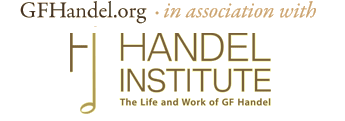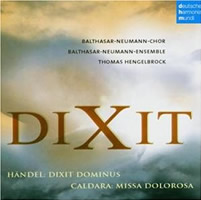Handel’s monumental settings of this psalm for soloists, five parts choir
and orchestra was first performed in Rome in 1707. In the 1980s it was
argued that the psalm might have been part of the so-called ‘Carmelite
vespers’, although the most recent hypothesis claims it was performed on the
name day of King Philip V of Spain. There are already many good versions of
Handel’s Dixit Dominus, but from the beginning to the end, this
recording is characterized by beautiful orchestral texture and vivid
tempi – Hengelbrock is even a few seconds ‘faster’ than Minkowski. The
frequent discussion about fast or slow tempi is often missing the
point. This ‘fast’ recording is a good occasion to remember that the tempo
itself is nothing alone. The vivid tempi are here combined with
accurate articulation, musicality, admirable senses of colours and drama,
and great care concerning the text and its meanings. The result is totally
coherent: a very expressive and achieved interpretation. For example, listen
to the powerful but not grandiloquent opening, the abrasive aspect of
‘Juravit Dominus’, the wonderful contrasts and linkings of the ‘Dominus a
dextris tuis’ or the famous soprano duet with choir ‘De torrente’. No doubt
one can imagine greater solo voices, but would that really be desirable when
this performance has such a marvellous atmosphere?
One of the particularly interesting aspects of this recording is the
performance of the orchestra. Hengelbrock uses a strong continuo –
the two theorbos, very active and efficient, could bother some listener’s
ears or brains – and the sound recording offers a good balance between the
choir and the orchestra. The orchestra not being crushed by the choir is a
really good point, especially because they are both excellent and thus the
orchestra is really involved through its important illustration of the
text.
The less achieved aspect of this recording is certainly the performance of
the soloists, who are members of the choir. Though excellent, Handel’s
writing and their conductor are so demanding that sometimes they seem to be
very close to their technical limit. Furthermore, the sound recording tends
to present them as being at the back of the choir, but it is worth noting
that listening to this on an SACD player enables a slightly better balance
between the soloists, choir and orchestra. The programme is completed with
two beautiful works by Antonio Caldara, although the interpreters seem to be
less at ease in these.
Hengelbrock offers us a declamatory Dixit Dominus – almost a
proclamation! – which perfectly illustrates both the text and Handel’s
treatment of Italian expressiveness and virtuosity. Some could consider that
John Eliot Gardiner’s Monteverdi Choir offers a slightly higher standard of
execution (Philips, 2001), but Gardiner’s approach, though powerful, is more
detached and mannered, and the more reverberated acoustics are prejudicial
to the accuracy and the clarity of the listening. Hengelbrock’s Dixit
contains the most evident greatness, reserve, power, and emotion.




